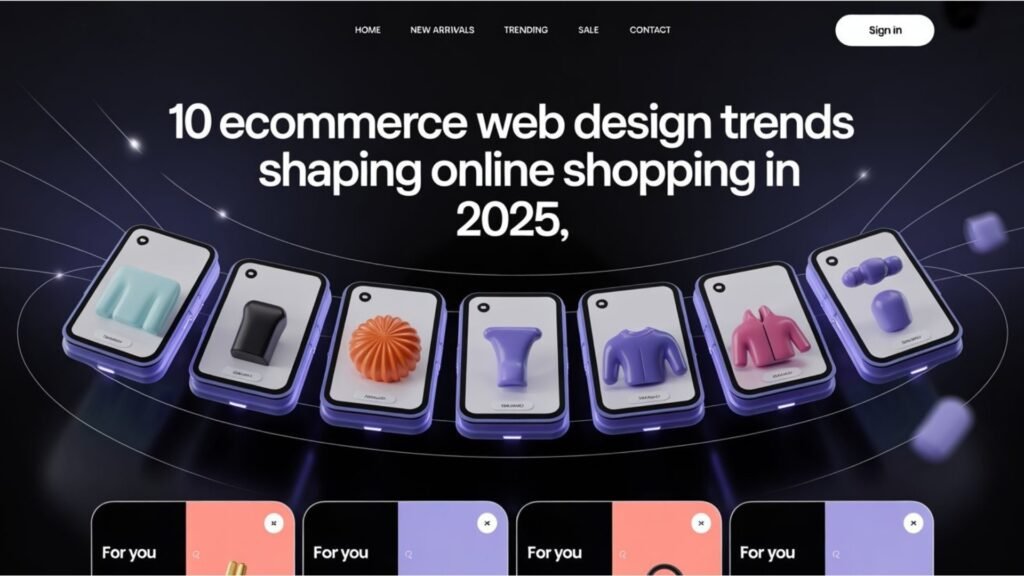Staying ahead of the curve is not just an advantage—it’s a necessity. The ecommerce web design trends for 2025 are transforming how brands capture customer interest, build trust, and drive conversions. With nearly 61% of US adults believing mobile shopping is essential for convenience, adopting online shopping web design trends that prioritize user-centric mobile experiences is crucial.
According to this Statista report, global online retail sales are projected to surge past $7 trillion by the end of 2025—an unprecedented milestone that reflects expanding digital market reach and evolving consumer expectations. As shoppers demand richer, faster, and more personalized experiences, embracing the latest ecommerce web design trends is critical. From immersive 3D product showcases to powerful AI in ecommerce web design and sustainable UX cues, these modern ecommerce design trends drive engagement, loyalty, and revenue growth in today’s crowded marketplace.
Here are the 10 key ecommerce web design trends shaping the online shopping landscape this year.
1. Hyper-Personalization and AI-Driven Experiences
Artificial Intelligence is moving beyond simple recommendations to deeply personalized interfaces. In 2025, AI in ecommerce web design enables layouts, content, and product offerings to dynamically adapt to individual behaviors and preferences, defining this as a core modern ecommerce design trend.
AI-powered shopping guides, dynamic content highlighting relevant products, and personalized navigation are key components of interactive ecommerce design. Achieving this requires skilled teams, such as those specializing in custom web design in Dubai, to weave these elements into seamless, user-friendly experiences.
Also Read This: AI in Digital Marketing: Benefits and Challenges
2. Interactive 3D Models and Augmented Reality (AR)
Bringing products to life is a transformative interactive ecommerce design trend. Customers can rotate, zoom, and inspect 3D models as if handling items in person, which builds confidence and reduces hesitation.
AR takes this further by letting shoppers “try before they buy,” especially in sectors like home decor and fashion. The AR market in ecommerce is projected to soar, making this a pivotal online shopping web design trend that blends physical and digital experiences seamlessly.
3. Mobile-First Design as a Standard
With m-commerce set to generate $558.29 billion in the US by 2024, mobile-first design remains a fundamental ecommerce website UI trend not to ignore. Beyond responsive layouts, it demands touch-friendly interfaces, fast load times, and smooth mobile checkout flows—cornerstones of ecommerce web design trends today.
4. Immersive Video Content
Video content is now an essential part of modern ecommerce design trends. Above-the-fold background videos establish brand tone, while product demos clarify features and benefits. Using video increases visitor engagement by 88%, making it a vital tool in interactive ecommerce design.
Also Read This: How to Use Digital Marketing to Enhance Brand Awareness
5. Bold Minimalism and Expressive Typography
Clean layouts paired with striking typography define this ecommerce web design trend. Minimalism directs focus to products and messages, while bold fonts infuse personality. This shift toward clarity and impact is reshaping online shopping web design trends for 2025.
6. Neubrutalism and Anti-Design
For brands wanting unique visual identities, neubrutalism offers a high-contrast, raw aesthetic as part of modern ecommerce design trends. Likewise, anti-design embraces intentional chaos and imperfection for a more authentic feel. These bold approaches can differentiate niche ecommerce sites but require balance to maintain usability.
7. Micro-Interactions and Purposeful Animations
Refined micro-interactions enrich the user journey by providing feedback and delight within ecommerce web design trends. From hover effects to animated “add to cart” buttons, these purposeful animations improve usability and inject playfulness into interactive ecommerce design.
Also Read This: The Power of Micro-Influencers & User-Generated Content in Dubai
8. Advanced, Frictionless Navigation
Finding products must be effortless—this is a growing demand in ecommerce website UI trends. Personalized menus and AI in ecommerce web design combine to deliver relevant suggestions and natural language search capabilities, which reduce bounce rates and improve conversions.
9. Dark Mode and Low-Light Themes
Dark mode is now an expected feature in online shopping web design trends. Low-light themes reduce eye strain and create sleek, modern aesthetics, allowing users to customize their browsing experience comfortably.
10. Sustainable and Performance-Conscious Design
Sustainability is a vital consideration in ecommerce web design trends. Eco-conscious practices like optimizing images, clean coding, and green hosting decrease digital carbon footprints while speeding up site performance—benefiting both users and the environment. Green and efficient design is becoming a must-have in modern ecommerce design trends.
The Tangible Benefits of Adopting These 2025 Ecommerce Web Design Trends
Understanding the latest ecommerce web design trends is one thing; knowing the concrete benefits they deliver is what drives investment. Embracing these modern ecommerce design trends is not about chasing fads—it’s about achieving specific, impactful business outcomes. Here’s what you gain by modernizing your storefront:
- Dramatically Higher Conversion Rates: Trends like Interactive 3D models, AR, and hyper-personalization directly address the biggest hurdle in online shopping: the inability to physically interact with a product. By providing richer information and a more confident shopping experience, you significantly reduce purchase hesitation and product returns, leading to a direct boost in sales.
- Enhanced User Engagement and Loyalty: Interactive ecommerce design elements, such as micro-interactions and immersive video, transform a static shopping trip into an engaging dialogue. A website that is a pleasure to use keeps visitors on the page longer, encourages exploration, and builds a positive emotional connection with your brand, turning one-time buyers into loyal advocates.
- A Powerful, Differentiated Brand Identity: In a crowded market, blending in is a failure. Adopting bold visual trends like expressive typography or neubrutalism allows you to craft a unique and memorable brand identity. This distinct visual language makes your store instantly recognizable and positions you as a leader, not a follower.
- Improved Operational Efficiency: Integrating AI in ecommerce web design does more than just personalize the front end. AI-powered search and navigation deflect routine customer service queries by helping users find what they need instantly. This reduces the load on your support team and streamlines the customer journey, making your business more efficient.
- A Strong Competitive Advantage: By implementing these forward-thinking online shopping web design trends, you future-proof your business. You are not just keeping up with competitors; you are setting a new standard for what an online store can be, attracting a tech-savvy audience and establishing your market position for years to come.
Why Choose CoDevlopp for Your Ecommerce Success?
When it comes to embracing the latest ecommerce web design trends, partnering with an experienced and versatile digital agency can make all the difference. CoDevlopp Digital Media offers a full suite of services designed to build, enhance, and promote your online presence effectively. From custom website and ecommerce design to UI/UX optimization, mobile-first development, and AI-powered personalization, CoDevlopp covers every aspect of creating a modern, high-converting online store.
Beyond design and development, their expertise extends to digital marketing, SEO, content writing, and social media management, providing an integrated approach to grow your brand in the competitive UAE and Dubai markets. CoDevlopp’s end-to-end solutions ensure your ecommerce platform stays updated with current design innovations while driving traffic, engagement, and sales.
Frequently Asked Questions (FAQs)
1. Why is mobile-first design critical for ecommerce in 2025?
Mobile-first design is essential due to the dominance of mobile shopping. Prioritizing mobile ensures a frictionless experience, which is key in current online shopping web design trends.
2. How is AI utilized in ecommerce web design?
AI personalizes shopping via dynamic product recommendations, conversational chatbots, and behavior-driven content, anchoring its role in AI in ecommerce web design.
3. Are brutalist or anti-design trends good for ecommerce?
These bold styles fit niche audiences within modern ecommerce design trends but should be balanced with usability for broader appeal.
4. How to easily add video to my ecommerce site?
Start with short demos replacing product images or add background videos for storytelling, following interactive ecommerce design best practices.
5. How can ecommerce sites become more sustainable?
Optimizing media, cleaning code, and selecting green hosting reduce energy use—important for sustainable ecommerce web design trends.
6. What mistakes to avoid when adopting new design trends?
Never sacrifice user experience for trends. Every element should guide and delight users without harming speed or accessibility within ecommerce website UI trends.






